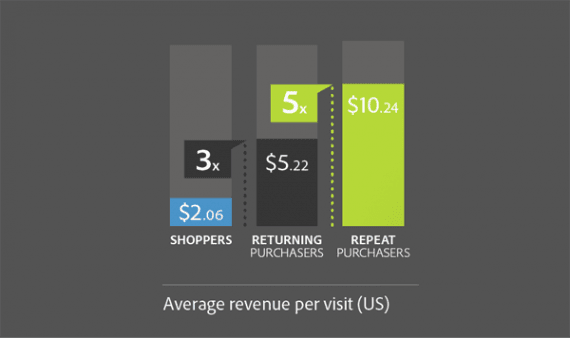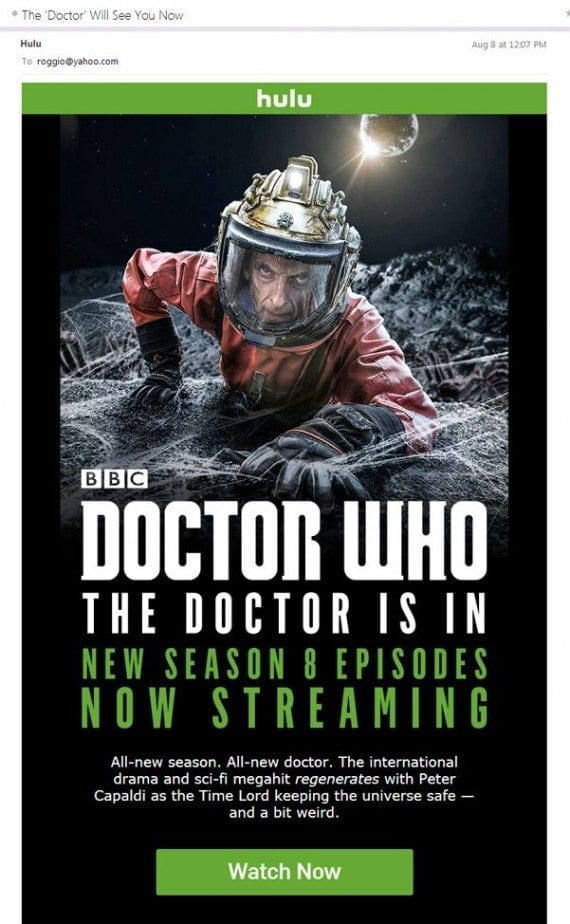When online retailers use email to market to loyal customers, those stores are applying one of their most effective marketing tools to some of their richest sales prospects.
Repeat customers are significantly more valuable than new shoppers. Shoppers familiar with an online store not only spend more over the lifetime of their relationship with the store, but they also tend to spend more on each visit.
An often cited Adobe study from August 2012 showed that shoppers who had returned to an online store for at least the third time to place an order spent an average of five times more per purchase than a new customer.

Adobe found that in the United States a repeat shopper returning for three or more purchases spent about five times as much as a new customer.
In October 2014, marketing automation firm Marketo reported that a loyal customer is likely to spend 67 percent more than new shoppers and will be worth, perhaps, 10 times as much as the value of their first purchase to the retailer over time.
Thus, some of the most valuable prospects an online store has are those customers who have already made a purchase.
Separately, email marketing is one of the most precise and powerful ways that an ecommerce company can communicate with shoppers, and email marketing generates some of the best possible return on investment, with various reports estimating that for each dollar spent on email marketing, companies could enjoy a return on investment of between $24 and $38.
Thus, it can be pretty smart business to send email messages to known customers.
What follows are six suggestions for marketing to existing customers.
1. First Order ‘Thank You’ Message
Each online order sparks a series of transactional emails intended to inform the shopper about the purchase. These transactional emails should include an order confirmation, a shipping notification, a delivery notification, and a follow-up email.
To this powerful series, add a special thank you or welcome message to new customers. The aim is to ensure that this new customer was completely satisfied with the purchase process.
This welcome email might include:
- A personalized thank you;
- Links to relevant content;
- Customer service contact information;
- A reminder about refunds and guarantees;
- A summary of the store’s brand or value statement.
2. Product Review Request Message
When a store sends a product review request email, that store is really creating three types, if you will, of return-on-investment opportunities.
First, there is strong evidence that product reviews and ratings can improve an individual product’s conversion rate.
Second, reviews can be reused in advertisements, social media posts, or as on-site marketing.
Third, when a customer returns to review a product, that customer is back on the store’s site and open to promotions.
The review-request email should thank the customer for her purchase, explain how reviews help other shoppers, offer a link to the review form, and not promise anything in return for the review.
After a review has been submitted, send a “Your review was published” email, thanking the customer for the review and offering an intrinsic reward, like a discount on a related or complementary product.
3. Share Your Experience Message
When a shopper shares his retail experience on social media, he is making a commitment that should help make him a loyal customer.
In his book, Influence: The Psychology of Persuasion, Dr. Robert B. Cialdini describes six principles of influence, including “Commitment and Consistency.” Essentially, Cialdini argues that once someone commits to something, like a particular online retailer, that person is more likely to behave in such a way as to honor that commitment.
As part of the purchase follow up, ask shoppers to share their experience on social media. In the email, include easy-to-use links for posting to Pinterest, Twitter, or Facebook. Reward shoppers who share.
Finally, if you can respond with a personal note on the social network the customer used, do it.
4. Reorder Reminder Message
Many products are, in some sense, consumable. For example, some health and beauty products simply run out, while some apparel wears out.
When it makes sense, send customers a reorder reminder email, encouraging them to return to the store. Be certain that the email is personalized for the products the customer uses and include a link directly to the checkout.
5. Personalized Recommendation Message
When a shopper makes repeat purchases, it is possible to make useful recommendations based on what and how she has purchased in the past.
Media companies, like Hulu, are particularly good at this. A recent email message from that company clearly recognized that I was a fan of British science fiction and offered episodes of Doctor Who, Misfits, The Fades, and Torchwood.

Make product recommendations based on what and how a customer has purchased in the past.
Use a recommendation engine to discover which complementary products make sense for each customer and send a customized, personalized list of suggested items.
6. Best Customer Message
The Adobe study mentioned above found that about 8 percent of online shoppers represented about 40 percent of online sales. These best customers can mean a lot to your business.
Every once in a while, send an email (and an offer) designed to delight your best customers. Often this will include a free gift, a special price, or early access to coveted products.




